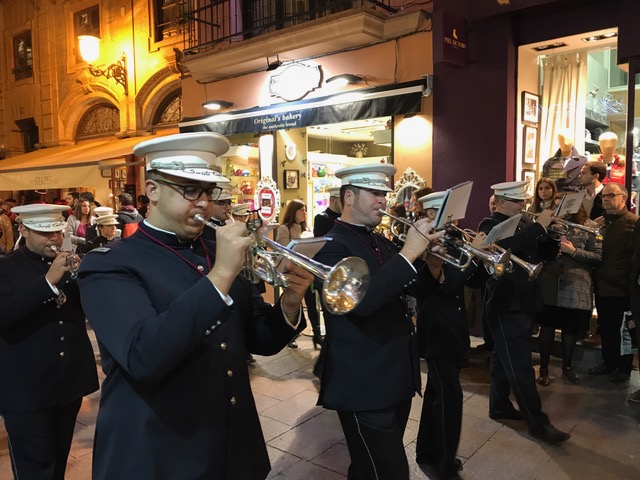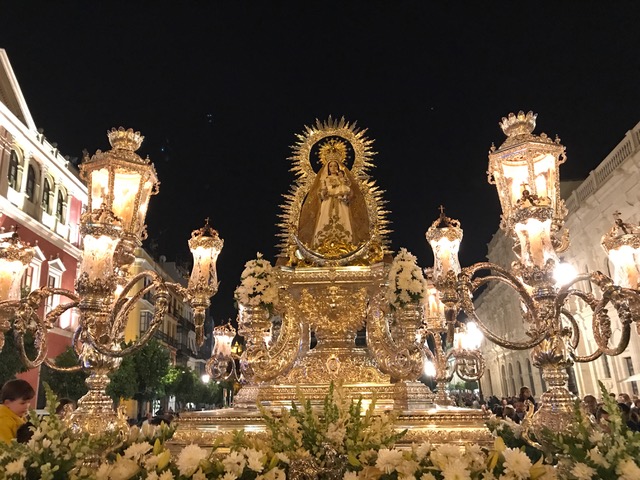
It is hard to learn much about the character of a nationality as a tourist. The locals tend to be putting their best (or, occasionally, their worst) foot forward, and the real life of a country goes on elsewhere than in hotel lobbies and on-and-off tour buses. T-shirt messages and souvenirs often play to stereotypes while real life mostly unfolds off-stage, unseen and unknown.
What’s more, appearances can deceive or, more benignly, be no more than appearances. The posture of the woman in the photo at the top of the post suggests dejection and defeat. Spain suffered those mightily during the financial downturn of 2008. Are people in Spain (or Andalucia or, more specifically, Seville) still suffering greatly? Or is this merely one lone woman lost in thought?
At the same time, impeccably turned-out women and men – especially older ones – are a common sight in Seville. Does this mean the Spanish are thriving now, or especially stylish, or just that men of a certain age are inclined toward rainbow suits?



And then there is Spain and religion. Wandering the streets on Saturday night, we stumbled into horde of Sevillanos jammed into the plaza outside the baroque L’Eglisia del Salvador (Church of the Savior). People of every age and possible situation had crowded into the square, all eyes trained on the open double doors, all obviously anticipating … well, what? Doris whipped out her trusty rusty Spanish to find out.
Una virgen was the answer. A virgin, soon to emerge from the church. Nothing special, the woman added helpfully. Hay muchas virgenes in Sevilla – there are many virgins in Seville. This happens all the time.
Within minutes, a brass band under the church portico struck up and began a solemn march down the steps and into the crowd.

Next through the great wooden doors came a thurifer (new word of the week) swinging a thurible and trailing clouds of incense, followed by a clutch of richly dressed clergy.

Finally, the virgin herself swung into view, a gilt icon reigning from atop a dazzling two-ton platform born on the shoulders of costaleros, costumed men concealed by a red velvet skirt. The crowd pressed toward the float – all the strutting teenagers, the mothers and fathers steering baby strollers, the limping pensioners. A great show of Spain’s enduring faith and religiosity.

Or maybe not.
To get beyond appearances, we took a class on Spanish culture at the language school where Louis is studying Spanish and Doris is studying French (another story). The teacher said stereotypes are imposed from outside, not assumed from within, and tend to be stronger outside a country than inside.
She tested the group on their ability to divine the true from the false in 32 generalizations about Spain and Spanish people, statements like –
- The Spanish are a little lazy
- The Spanish drink a lot of sangria
- The Spanish often eat paella
- The Spanish are very punctual
- Spain is a country that is extremely religious.
The answers: False, laughably false, very true, depends on the occasion and … false.
The Spanish are not particularly religious, she said. Like elsewhere throughout Europe, religion has faded as a force of life. The churches don’t have congregations any more, mass is not said in many of them. What appears religious to outsiders is, in reality, “anthropology” – a love of custom, tradition and fiestas.

Floats like the one we saw are the centerpieces of one of the city’s oldest and dearest customs/ traditions/ fiestas, Semana Santa. During the week before Easter for the last 450-plus years, nearly 70 church brotherhoods have carried their pasos through the streets for as long as eight hours at a stretch. Some of the floats (typically gold if depicting Jesus, silver for Mary) are so ancient and elaborate they are regarded as priceless works of art.
Somehow, we had stumbled into a display in miniature of this particular anthropology. We even joined in eventually, trailing the float as it stopped and started through the streets, so close we could see the white sneakers of the costeleros beneath the red skirt and hear the knock as the overseer dropped the heavy hammer fixed to the prow of the float that lets the bearers know it is time to move on.
Why one of the brotherhoods and its silver virgin and brass band were on the loose on a Saturday night in November, it will take a Sevillano we haven’t asked to tell us. What we know for now is that affirmed the stereotype that some of travel’s most memorable experiences are the ones that weren’t on the schedule.
Seville in the rear-view mirror:
- Catedral de Santa Maria de la Sede de Sevilla (better known as “Seville Cathedral) – the world’s fourth-largest church building and home of Christopher Columbus’ magnificent tomb

- Plaza de España – a Moorish-themed fantasy of extravagantly tiled pavilions, bridges, benches and more, built (much like San Diego’s Balboa Park) for a 1920s exhibition and then preserved because people fell in love with it.

- Alameda de Hercules (“the Alameda”) – a public promenade named after rows of poplar (álamos) trees that line it. Alternately elegant and derelict over its 443-year history, it is lined with cafes and recycling bins so we visited often. Its southern entrance is marked by columns salvaged from a Roman temple of early Seville.

Coming soon: Our own tales of the Alhambra

Fantastic web site. Lots of helpful information here. I am sending it to several friends
ans also sharing in delicious. And obviously, thank you on your sweat!
LikeLike
I am really inspired with your writing abilities as smartly as with the format in your weblog.
Is this a paid theme or did you customize it your self?
Either way keep up the nice quality writing, it’s uncommon to see a nice blog like this one these days..
LikeLike
Gosh, thanks for the compliment. We started the blog just so our friends and family could keep track of us. It’s always fun when someone else discovers it. And, in response to your question, we use one of WordPress’s “themes” for the site. I can’t remember whether it was an upgrade, but I don’t think we paid for it.
LikeLike
You two are quite a pair (as if there were any doubt!) these rapportages and photos are quite charming. Have you considered this for a book?
Luv ya
LikeLike
Loving history as I do, this has been a grand journey! Thank you, Doris
LikeLike
So do you think then that you two are as religious as the Spanish? Interesting information and wonderful pictures..enjoy
LikeLike
Bueno! Buenísimo! And how do you turn exclamations upside down anyway? Again, very wonderful photos, especially the glimpse of hand, especially the stereotype test with answers, especially more news of your travels. Thank you.
LikeLike
Thank YOU for sharing the road with us!
LikeLike
Wonderful lay of the land and people of Spain. Thanks for writing so descriptively. Hope your trip is splendiferious!
LikeLiked by 1 person
I can’t seem to figure out the “comments” section of the blog, if there is one. I did “‘like” your post. They should have a “LOVE” your post option. Or “Really, reeeeeeally love” your post. Like is just so milquetoast.
Thanks for taking me along to Spain. I want to see ALL of that country some day!
LikeLiked by 1 person
Haha. We are still figuring the comments out, too, but thanks for yours. (We think you can see them all by just clicking on the “comments” at the top. We hope!)
LikeLike
Loving this tour guiding us through Spain! Keep it coming!
LikeLiked by 1 person